Comparing Costs: School Meals – Natural Vs Non-Natural
When comparing costs for school meals, opting for natural over non-natural can impact your budget. Organic ingredients are pricier due to stringent regulations and high demand, while non-organic alternatives are usually more budget-friendly. Understand that the quality and sourcing of ingredients play a significant role in cost differences. Consider how choosing natural options may lead to financial benefits through improved health and reduced waste. The financial implications of organic versus conventional ingredients are essential for schools aiming for cost-effective meal solutions.
Cost Analysis: Organic Vs Conventional
When comparing the cost of organic and conventional school meals, it's essential to analyze the financial implications of choosing one over the other. Cost effectiveness plays a significant role in decision-making, but nutritional value is equally crucial. Organic meals are often perceived as healthier due to the absence of synthetic pesticides and fertilizers, potentially providing more health benefits to students. However, the price comparison between organic and conventional ingredients is where the analysis becomes intricate.
Studies have shown that organic ingredients generally come at a higher price point than conventional ones. This price disparity can directly impact the cost of preparing school meals. While organic foods are often associated with being more nutritious, the question of whether the added cost justifies the potential health benefits arises. Analyzing the nutritional value of organic versus conventional ingredients becomes imperative in determining if the higher cost of organic meals aligns with the desired health outcomes.
Furthermore, the availability and sourcing of organic ingredients can also influence the overall cost effectiveness of organic school meals. Factors such as location, seasonality, and demand can affect the prices of organic produce. Thus, when considering the cost effectiveness and nutritional value of organic versus conventional school meals, a comprehensive evaluation of price comparisons and health benefits is essential to make informed decisions for providing optimal nutrition to students.
Pricing of Organic Ingredients
Organic ingredients typically command higher prices compared to their conventional counterparts in the context of school meal preparation. When considering organic ingredient sourcing and price comparisons, it's essential to delve into the specifics:
- Quality Discrepancies: Organic ingredients are often priced higher due to the stringent regulations and certifications required for organic farming practices. This ensures higher quality but also contributes to increased costs.
- Production Costs: Organic farming methods tend to be more labor-intensive and often have lower yields compared to conventional farming. These factors play a significant role in the pricing disparities between organic and non-organic ingredients.
- Market Demand: The increasing consumer demand for organic products influences the pricing of organic ingredients. Higher demand can lead to higher prices as suppliers adjust to meet market needs.
- Supply Chain Complexity: Organic ingredient supply chains are generally more intricate than those of conventional ingredients. This complexity, which includes specialized handling and transportation requirements, contributes to the overall higher costs associated with organic ingredients.
Considering these aspects is crucial when assessing the pricing of organic ingredients for school meal preparation. While organic options may come at a higher cost, understanding the factors that influence these prices can help schools make informed decisions when choosing between organic and non-organic ingredients.
Budget Considerations for Non-Organic
Considering the cost-effectiveness of non-organic ingredients is essential for optimizing school meal budgets. By implementing cost-saving strategies and exploring budget-friendly alternatives, schools can provide nutritious non-organic meals while being mindful of expenses. Non-organic options often present opportunities to save on costs compared to organic ingredients, making them a practical choice for many school meal programs.
One cost-saving strategy for non-organic meals is to bulk purchase ingredients. Buying in larger quantities can often lead to discounts from suppliers, reducing the overall cost per unit. Additionally, seasonal produce can be more affordable, so planning menus around what's in season can help lower expenses. Another approach is to work with local farmers or distributors to source non-organic ingredients at competitive prices, supporting the community while keeping costs down.
Opting for frozen or canned non-organic produce can also be a budget-friendly alternative. These options have a longer shelf life, reducing the risk of waste and saving money in the long run. When planning non-organic meals, consider incorporating cost-effective proteins like beans, lentils, or eggs, which provide essential nutrients at a lower price point than some meats.
Expenses of Organic Meal Planning
To effectively manage the budget for school meals, it's crucial to understand the financial implications of incorporating organic ingredients in meal planning. When considering organic meal prep, ingredient sourcing plays a significant role in determining overall costs. Here are some key factors to consider:
- Ingredient Costs: Organic ingredients are generally more expensive than non-organic ones due to the higher costs associated with organic farming practices. When planning organic meals, be prepared for potentially higher ingredient costs compared to non-organic options.
- Seasonal Variability: The availability of organic ingredients can fluctuate seasonally, affecting their prices. It's essential to consider seasonal variations in ingredient costs when meal planning to ensure budget stability.
- Bulk Purchases: Buying organic ingredients in bulk can sometimes lead to cost savings. However, it's crucial to balance bulk purchasing with the shelf life of organic products to avoid waste and additional expenses.
- Local Sourcing: Opting for locally sourced organic ingredients can impact costs. While local sourcing may support the community and reduce transportation expenses, it's essential to compare prices with non-local options to determine the most cost-effective choice for your school meal program.
Understanding the expenses associated with organic meal planning, particularly in terms of ingredient costs, seasonal variability, bulk purchases, and local sourcing, is essential for effective budget management in school meal programs.
Financial Impact of Natural Options
When comparing school meal costs, analyzing the financial impact of incorporating natural options provides valuable insights into budget management strategies. The financial savings associated with choosing organic ingredients over processed ones can significantly impact the overall cost effectiveness of school meal programs.
Organic ingredients, although initially perceived as more expensive, can lead to long-term financial benefits. While the upfront costs of organic options may be higher than processed alternatives, the quality and nutritional value they offer can result in reduced healthcare expenses in the future. By investing in natural options, schools can promote healthier eating habits among students, potentially lowering the risk of diet-related health issues and thus saving on medical costs down the line.
Moreover, the cost effectiveness of natural options extends beyond healthcare savings. Organic ingredients often have higher nutrient content, meaning that smaller portions can provide the same level of satisfaction and nourishment as larger servings of processed foods. This efficiency in portion sizes can lead to reduced food waste, contributing further to the financial benefits of incorporating natural options into school meal plans.
Comparison of Organic and Non-Organic Prices
In evaluating school meal costs, a detailed comparison of prices between organic and non-organic options reveals essential insights into budget allocation strategies. When considering the price comparison and quality difference between organic and non-organic school meal options, several key points emerge:
- Price Comparison: Organic meals generally come at a higher price point compared to non-organic alternatives. The organic certification process, strict farming standards, and limited use of synthetic pesticides contribute to the higher cost.
- Quality Difference: While organic meals may be pricier, they often boast higher quality ingredients. Organic foods are grown without synthetic pesticides or fertilizers, leading to a perception of better taste and environmental sustainability.
- Cost Effectiveness: Non-organic school meals are typically more cost-effective for budget-conscious institutions. The lower price point of non-organic foods can help schools provide meals to a larger student population within budget constraints.
- Nutritional Value: Despite the price disparity, both organic and non-organic school meal options can offer similar nutritional value. Studies suggest that the nutritional benefits of organic foods may not significantly outweigh those of conventionally grown foods, indicating that non-organic meals can be a viable choice for schools looking to balance cost and nutrition.
Understanding the price discrepancies and quality differences between organic and non-organic school meals is crucial for schools seeking cost-effective yet nutritious meal options for their students.
Evaluating Costs for Organic Meals

Organic meal costs present a significant consideration in the overall budgeting process for schools providing meal options to students. When evaluating the costs for organic meals, it's essential to consider various factors such as budget constraints, ingredient sourcing, cost-effective meal planning, and nutritional value.
Budget constraints play a crucial role in determining the feasibility of incorporating organic meals into school menus. While organic ingredients are often more expensive than their non-organic counterparts, schools must find ways to balance the desire for organic options with the limitations of their budget. This may involve exploring partnerships with local farmers or seeking out bulk purchasing options to help reduce costs.
Ingredient sourcing is another key aspect to consider when evaluating the costs of organic meals. Schools that prioritize organic options must ensure that their suppliers meet the necessary organic certification standards. This can sometimes result in higher ingredient costs, but it's essential for maintaining the integrity of the organic label.
Cost-effective meal planning is essential for schools looking to provide organic meals within budgetary constraints. By carefully designing menus that make the most of seasonal produce and cost-effective organic ingredients, schools can offer nutritious meals without overspending.
Lastly, considering the nutritional value of organic meals is crucial. While organic options may have higher upfront costs, they often offer increased nutritional benefits, which can contribute to the overall health and well-being of students. By prioritizing quality ingredients and mindful meal planning, schools can provide organic meals that are both cost-effective and nutritious.
Affordability of Natural School Meals
For schools evaluating the affordability of natural school meals, it's essential to consider various cost factors and strategies to ensure financial sustainability while providing nutritious meal options for students.
- Budgeting tips: Begin by analyzing your current budget allocation for school meals. Look for areas where cost savings can be made without compromising on the quality of ingredients. Consider negotiating prices with local suppliers or buying in bulk to reduce costs.
- Meal prep strategies: Efficient meal prep can significantly impact the affordability of natural school meals. Plan menus in advance to avoid last-minute expensive purchases. Utilize seasonal produce that tends to be more cost-effective and plan meals that can use common ingredients across different dishes to minimize waste.
- Track expenses: Keep detailed records of all expenses related to natural school meals. Regularly review these records to identify any cost fluctuations or areas where overspending may be occurring. This data-driven approach can help in making informed decisions to optimize budget utilization.
- Community partnerships: Forge partnerships with local farmers, community gardens, or food cooperatives to access fresh, affordable produce. These partnerships can't only support the local economy but also provide schools with access to high-quality ingredients at competitive prices. Consider organizing community events or fundraisers to further support the sustainability of natural school meals.
Conclusion
In conclusion, when comparing costs between natural and non-natural school meals, the financial impact of organic options must be carefully considered.
While organic ingredients may come at a higher price, the long-term benefits of healthier, more nutritious meals may outweigh the initial expenses.
It's important to evaluate the affordability of natural school meal options in order to make informed decisions that prioritize the well-being of students.
